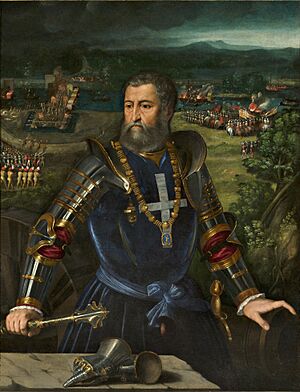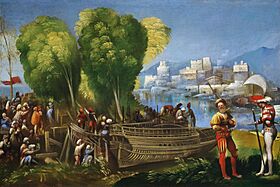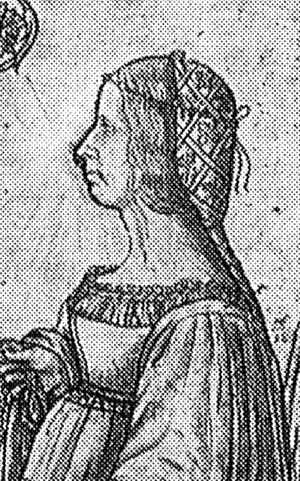Alfonso I d'Este facts for kids
Quick facts for kids Alfonso d'Este |
|
|---|---|
| Duke of Ferrara Duke of Modena and Reggio |
|
| Reign | 25 January 1505 - 31 October 1534 |
| Predecessor | Ercole I d’Este |
| Successor | Ercole II d'Este |
| Born | 21 July 1476 Subiaco, Papal States |
| Died | 31 October 1534 (aged 58) Ferrara, Duchy of Ferrara |
| Spouse | Anna Sforza (m. 1491; died 1497) Lucrezia Borgia (m. 1501; died 1519) Laura Dianti (m. 1534) |
| Issue Detail |
Ercole II d'Este, Duke of Ferrara Ippolito II d'Este Leonora d'Este Francesco d'Este, Marchese di Massalombarda Alfonso d'Este, Lord of Montecchio (illegitimate, father of Cesare d'Este) |
| House | Este |
| Father | Ercole I d'Este |
| Mother | Eleanor of Naples |
Alfonso d'Este (born 21 July 1476 – died 31 October 1534) was an important ruler in Italy. He was the Duke of Ferrara and also the Duke of Modena and Reggio. He ruled during a time of many conflicts known as the Italian Wars.
Contents
Life as Duke

Alfonso was the son of Ercole I d'Este, Duke of Ferrara and Eleanor of Naples. He became duke in January 1505 after his father passed away.
Family Challenges
Early in his rule, Alfonso discovered a plot against him. His brother Ferrante and half-brother Giulio d'Este were involved. They wanted to remove Alfonso from power.
In September 1506, they were put on trial. They were sentenced to death, but Alfonso changed their punishment to life in prison. They were held in the Torre dei Leoni. Ferrante died in prison after 34 years. Giulio was released after 53 years, in 1559. People in Ferrara made fun of Giulio's old-fashioned clothes. He died in 1561.
Wars and Military Strength
During the Italian Wars, Alfonso managed to keep his duchy safe. He was very flexible and watchful. His city, Ferrara, had strong defenses. He joined the League of Cambrai against Venice. He stayed friends with Louis XII of France even when Pope Julius II made peace with Venice.
When people in Bologna rebelled against Pope Julius, they tore down a statue of the Pope. Alfonso took the pieces and used them to make a powerful cannon. He named it La Giulia and placed it on his castle walls.
In 1510, Pope Julius II removed Alfonso from the Church. He also declared that Alfonso had lost his lands, wanting to add Ferrara to the Papal States. But Alfonso fought back successfully. He won the Battle of Polesella and captured Bologna. He also helped the French win the Battle of Ravenna (1512).
Alfonso's success came from Ferrara's excellent artillery. He had his own foundry that made the best cannons of that time. In his portraits by Titian, Alfonso is shown with his arm resting on a cannon. This shows how proud he was of his military power.

Later, in 1526–1527, Alfonso joined Charles V, Holy Roman Emperor in a fight against Pope Clement VII. In 1530, the Pope finally recognized Alfonso as the rightful ruler of Modena and Reggio again.
Marriages and Children
Alfonso had three marriages during his life.
First Marriage
In January 1491, Alfonso married Anna Sforza. She was the niece of Ludovico Sforza, the Duke of Milan. At the same ceremony, Ludovico married Alfonso's younger sister, Beatrice d'Este. This double wedding was planned by the famous artist Leonardo da Vinci.
This marriage was meant to strengthen the ties between the two powerful families. However, Anna Sforza died in November 1497. Beatrice d'Este had also passed away earlier that same year.
Second Marriage
Alfonso married again in 1501 to Lucrezia Borgia. They had several children:
- A daughter who was stillborn (1502)
- Alessandro d'Este (1505–1505)
- Ercole II d'Este, Duke of Ferrara (born 5 April 1508 – died 3 October 1559)
- Ippolito II d'Este (born 25 August 1509 – died 1 December 1572). He became an Archbishop and later a Cardinal.
- Alessandro d'Este (1514–1516)
- Leonora d'Este (born 3 July 1515 – died 15 July 1575). She was a nun and a composer.
- Francesco d'Este, Marquess of Massalombarda (born 1 November 1516 – died 2 February 1578)
- Isabella Maria d'Este (born and died on 14 June 1519)
Third Marriage
After Lucrezia died in June 1519, Alfonso married Laura Dianti. They had two sons, Alfonso and Alfonsino d'Este.
Art and Music Patronage

Alfonso d'Este was a great supporter of art, just like his brother Ippolito I. He hired famous artists to create beautiful works for him.
His Art Gallery
In 1514, the elderly artist Giovanni Bellini painted The Feast of the Gods for Alfonso. This was Bellini's last finished painting. Alfonso then asked Bellini's student, Titian, to paint more works.
In 1529, Alfonso created a magnificent art gallery called his studiolo or camerino d'alabastro. This means "small alabaster room." He wanted to display his art against white marble walls under a golden ceiling. The pale marble gave the room its name.
Titian painted two portraits of Alfonso. One was so admired that Michelangelo praised it. The Holy Roman Emperor Charles V even asked for it as a diplomatic gift. Alfonso then had Titian paint a copy for him.
Over the next 20 years, Titian added three more famous paintings to Alfonso's room: The Worship of Venus, The Bacchanal of the Andrians, and Bacchus and Ariadne. Another artist, Dosso Dossi, also painted a large scene and ceiling decorations. He also created a painted border showing scenes from the Aeneid, but with the heroes dressed in modern clothes. All the paintings in this room were about love, and some even referred to marriage.
After the Este family lost control of Ferrara in 1598, the artworks from this special room were spread out to different places.
Music at Court
Alfonso also continued his father's tradition of making Ferrara a center for music. He brought some of the most famous musicians of his time to his court. They worked as composers, instrumentalists, and singers. Musicians from northern Europe, like Antoine Brumel and Adrian Willaert, worked for him. Willaert later became the founder of the Venetian School of music. This would not have happened without Alfonso's support.
Later History of the Este Family
Alfonso's grandson, Alfonso II d'Este, was the duke mentioned in Robert Browning's famous poem "My Last Duchess". Alfonso II did not have any sons to take over. This meant the main line of the d'Este family ended.
A grandson of Alfonso I, Cesare d'Este, was born outside of marriage. The Emperor recognized him as a ruler, but the Pope did not. The Pope then took the Duchy of Ferrara by force. However, the House of Este continued to rule in Modena and Reggio.
See also


